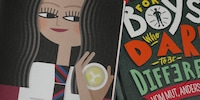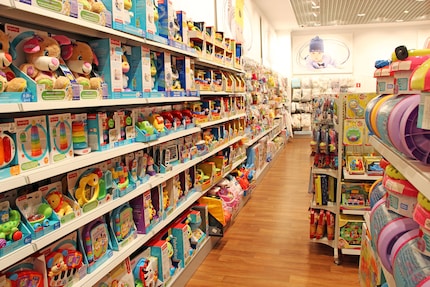
Background information
7 successful products invented by children
by Michael Restin

How do I find the right toy? Is a wooden puzzle better than a flashing electronic cube? And when is high tech too high tech? Developmental psychologist Lieselotte Ahnert is a new member of Fisher-Price’s team of experts. Here’s what she says.
If you’ve ever looked for something to gift a toddler, you’ll know to expect a jungle of toys. Big, small, colourful, loud, flashing, wooden, plastic – it’s nigh impossible to keep track of. And what even makes a useful present? German psychologist Liselotte Ahnert has been studying child development for years and recently joined the team of experts at toy manufacturer Fisher-Price. In our interview, the 70-year-old reveals what matters when it comes to toys – and why electronic toys are better than they’re given credit for.
Professor Ahnert, you’re the new «Fisher-Price expert» – that sounds like fun. Does your job involve playing a lot of games?
Lieselotte Ahnert: As a developmental psychologist, I researched childhood developmental conditions for many years and did actually play with children a lot. In the case of young children, who have very rudimentary language skills, play above all offers many insights into their inner world. It also creates excellent opportunities for imparting knowledge to the child, promoting language development and supporting early motor and emotional development.
How exactly do you now apply your knowledge within Fisher-Price?
I’m part of a team of experts. My role includes explaining the development of young children – how they handle objects, how they interact with toys. I answer questions like: what’s the child thinking? How can the child’s development be nurtured in a sensible way? And what’s harmful? All based on findings from my years of research.
Anyone looking to pick out a toy these days will be quite literally hit over the head by the sheer abundance of offers. How can parents find the right one for their child?
The age label is a good place to start. Children develop very rapidly during their first years of life; there are already striking differences between one-year-olds and two- to three-year-olds. Each stage of development has its own set of milestones that are age-dependent and that differ greatly from one another.

But not all children reach the same developmental milestones at the same age.
That’s true. These milestones can vary greatly from child to child within the same age group. The latest research in child development also takes factors from behavioural genetics into account; while one child may respond to musical stimuli, another may be interested in technical processes, such as building, or in nurturing activities, such as playing with dolls. Parents are aware of their child’s preferences and should choose toys accordingly.
Does it make sense to disregard individual preferences at times in order to offer the child new opportunities for play?
As far as I’m concerned, trying out a completely new toy – buying, say, a doll for the tech-savvy child and a fire truck for the nurturing child – is not the way to go. From a very early age, children independently align their activities and interests according to their developmental needs. So, sooner or later, they’ll ignore opportunities for play that don’t comply with their needs.
In your eyes, what makes a «good» toy?
One that’s in the child’s area of interest. Here, too, it should be a toy that was developed for the given age range, so the child also has the necessary skills. Ultimately, the toy must be appropriate for the child’s developmental stage and must not be too taxing.
But it should be challenging, right?
Yes, a good toy must also have the potential to lead the child to the next stage of development. In other words, it should encourage the child to try something new. Parents can demonstrate these possibilities during play with a few simple strategies.
Such as?
Parents can specifically guide the child to use the toy differently. They can also prompt the child to do so by asking questions, and then maintain their interest with praise and encouragement. Or they can let the child play independently, but let them know from time to time how well they’re using and expanding their skills in doing so. In developmental psychology, the terms we use for this are coaching, guidance, reinforcement, and feedback.

How have toys changed in recent years in connection with findings from developmental psychology?
The theory used to be that a toy should capture a child’s undivided attention and stimulate and expand their range of activities. It was accepted that a toy should be attractive in colour and usable in a variety of ways, including for imitating everyday events. However, modern developmental psychology research has shown that young children want to play with others by the end of the first year of life. So, toys allowing for a range of interactions and which are also fun for parents become increasingly important.
And what are parents into?
Parents are also entertained by toys that surprise them – innovative, creative and novel toys. Something they don’t already know from their own childhood.
There’s a recurring line that goes something like this: «Back in the day, toys were better and still made of wood – not like today.» Is this true?
Yes and no. Wooden toys are sturdy, free of harmful substances and sustainable. Due to their excellent material properties, they’ve proved themselves in toy production in the long term.
What are wooden toys lacking?
A child should have a variety of visual, haptic and acoustic experiences during the first months of life. A varied range of toys is essential for such experiences. This means including materials such as fabric, light metal and plastic in addition to wood. But it goes without saying that they must also be free of harmful substances and safe for children.
Children today are growing up in the digital age, and toys are following suit in the form of electronic educational toys. Is this harmful?
Modern developmental psychology has already proved several times over that even babies can distinguish between an animate and inanimate environment. This points to them knowing that the animate environment is characterised by independent activity and intentional action, whereas the inanimate environment is inactive and must first be «moved». In this respect, a toy that requires the child to push a button is very attractive and an immediate confirmation of this distinction. Becoming familiar with the technical processes of our modern world as a result of these toys is undoubtedly beneficial to the child’s development in the long run.
At what point does an abundance of electronics become too much?
It’s questionable what knowledge a child acquires when simply repeating a technical action over and over again. That is, when the child is just senselessly pushing buttons or tapping around on a tablet – without performing a logical operation, such as combining or adding things. A child’s interaction with technology shouldn’t amount to only that.
Are there any classics among toys that have remained virtually unchanged for years?
Quite a few, in fact. Friedrich Fröbel (1782–1852) and Maria Montessori (1870–1952) were the first to recognise that children’s play can support development, stimulate their curiosity and thinking, promote growing skills, and advance learning. Fröbel and Montessori are considered the pioneers of early education. To this day, their playthings are indispensable in the manufacturing of toys and include building blocks, puzzles, sorting and plugging toys and much more, and are also offered as crafting and building sets.
About the interviewee: Lieselotte Ahnert is a Professor of Developmental Psychology in the Department of Applied Developmental Science at Freie Universität Berlin and a Fisher-Price expert. Her research includes extensive studies on the developmental conditions of children. You can read more in her book «Wieviel Mutter braucht ein Kind?» (English: «How much mothering do kids need?»), published in 2020 by Beltz-Verlag. It’s available for purchase at Exlibris, for example.
Mom of Anna and Elsa, aperitif expert, group fitness fanatic, aspiring dancer and gossip lover. Often a multitasker and a person who wants it all, sometimes a chocolate chef and queen of the couch.
Interesting facts about products, behind-the-scenes looks at manufacturers and deep-dives on interesting people.
Show all